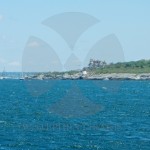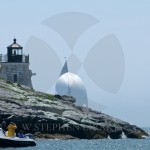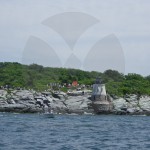When I was very young I subscribed to the notice to mariners and read every newsletter. Obviously things have changed over the years. The Brenton Reef Lightship was replaced by the Tower and both no longer exist. Personally, I would not make the proposed change. I have stories to support my beliefs. At the finish of an Annapolis-Newport race in heavy fog at night,I knew what to look for and helped guide us (Boomerang) across the finish line, which was a bearing from Castle Hill. “Flyer” which went on to win the round the world race that year was not so lucky, she found kettle bottom and had to be pulled off the rocks. (The navigator can to see me,he was so shaken by having missed the finish, he eventually withdrew from the round the world race)
Good afternoon fellow mariner,
The Coast Guard is considering making a change to the sound signal currently installed on Castle Hill Light, and we seek your comments on this proposed change.
The proposed change involves removing the traditional horn that sounds only during fog or periods of low visibility (such as snow), and installing an “on-demand” foghorn that is activated only when needed by mariners, who would activate the foghorn signal via VHF radio.
There would be no other change to the foghorn’s characteristics, i.e., the new horn would sound at the same decibel level as it does now, and would sound at the same interval (1 short blast every 10 seconds). During times of reduced visibility the new fog signal would be activated by turning to a CG-designated marine VHF-FM channel and keying the microphone five times consecutively, which would sound the foghorn for 45 minutes.
This change would, in the Coast Guard’s opinion, continue to provide an effective aid to navigation for mariners while also providing a better quality of life for residents in the nearby areas of Newport and Jamestown who are occasionally subject to long periods of time when the foghorn may be sounding, yet there are no mariners in the area actually using the signal to navigate.
Radio-activated foghorns are not new. One has been installed and in use since September of 2008 at Hog Island Light in Narragansett Bay. We have received no adverse comments from mariners regarding this aid. Also, radio-activated foghorns are used exclusively in U.S. waters of the Great Lakes, where there are no longer any traditional foghorns in use. Radio-activated foghorns can provide an effective aid to mariners, have less initial and maintenance costs than traditional foghorns, and reduce noise for nearby residents.
Please provide any comments you may have regarding this proposed change to Lieutenant Brock Nelson of Coast Guard Sector Southeast New England, who may be reached at 401-435-2348, or Brock.E.Nelson@uscg.mil. The deadline to submit comments is 31 October 2012.
Please feel free to pass this e-mail on to others who may have an interest in navigation safety and the fog horn at Castle Hill Light.




We hit Kettlebottom rock doing about 9 knots! Talk about an abrupt stop to the Annapolis to Newport race. We actualy got off under our own power and went straight to Newport Offshore to be hauled out to check for damage which was a lot less then was expected thanks to Huisman’s great build of Flyer.
The navigator was asked to withdraw from being the navigator on Flyer for the Round the World race by the owner. We had a visual on the Brenton Reef tower but he lost his way to Newport finish line off Castle Hill light in that short distance. We went on to a succesfull Whitbread with a new navigator. I now often go plugging for stripers around Kettelbottom and still look for blue bottom paint on the rock.